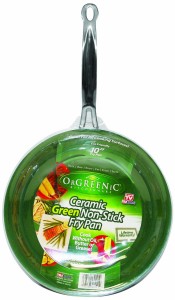I have a list of things that would be nice to have. When I want something, it goes on the list. If it’s still on the list after a month, then I will think about purchasing it.
A non-stick flat surface went on my list awhile back. My nine year old doesn’t like to eat his veggies, but loves pizza. I found a recipe on the net for a cauliflower crust pizza with great reviews: http://www.eat-drink-smile.com/2011/04/cauliflower-crust-pizza.html . It looked great so I made it, but the experiment was an epic disaster. The crust ended up being glued to the cookware and no amount of peeling or prying could budge it. Dinner ended up being a peanut and butter sandwich. Hence the non-stick surface went on my list.
The commercial for the Orgreenic cookware shows eggs and cheese totally sliding after cooking. It made it seem like nothing would stick – that’s what I was looking for. In my previous quest with Kohl’s cash to make a purchase that would not be subject to hedonic adaptation [ http://www.independentpenguin.com/an-experiment-in-overcoming-hedonic-adaptation/ ] I had eyed the frying pan, but it was $20 and after tax would exceed my allotted budget for the task.
But last week I found the pan on sale at our local grocery store for $10, so I got it.
The reviews on Amazon are amazingly bimodal – a group at 5 stars (excellent) and a group at 1 star (terrible) and very few opinions between.
When I got it home and opened it, I read the instructions on use. The first step was seasoning the pan. I chose to use Olive Oil and heating in the oven at 300 degrees for an hour. I didn’t actually think about it much at the time but looking back I did some things well unintentionally. I coated it in the Olive oil and then wiped it out so the pan looked dry. After heating, I let the pan cool again before wiping. After seasoning the pan, I started wondering why pans have to be seasoned, and found this great webpage on the chemistry of seasoning cast ironware: http://sherylcanter.com/wordpress/2010/01/a-science-based-technique-for-seasoning-cast-iron/ , Basically on cast iron, the oil polymerizes on the pan surface to form the coating. If something similar on happening on the Orgreenic (which seems reasonable) the way I seasoned left a nice coating. If I had read the cast iron blog before doing it, I would have used flaxseed oil as the seasoning. On the other hand, the flaxseed oil might have cost more than the pan – so perhaps I am lucky to have not read it first!
Last night I made the cauliflower pizza in the flat bottom of the Orgreenic pan (just popped the pan in the oven). I didn’t use any aid to prevent sticking – just the seasoned ceramic surface to put the pizza crust “dough” on. Cooked per instructions and ….
The entire pizza slipped right out of the pan in a perfect one round piece! The splatters of pizza sauce or stray cheese that burned on the side of the pan? A paper towel wiped them right off with no residue. The pan looked new after wiping it out.
I’m impressed. Put me in the five star camp. After reading some of the one-star reviews on amazon and the comments in the cast-iron blog linked earlier in this post, I suspect that many of the problems people have had with this pan are due to seasoning issues.
And my son gave two thumbs up on the pizza.



